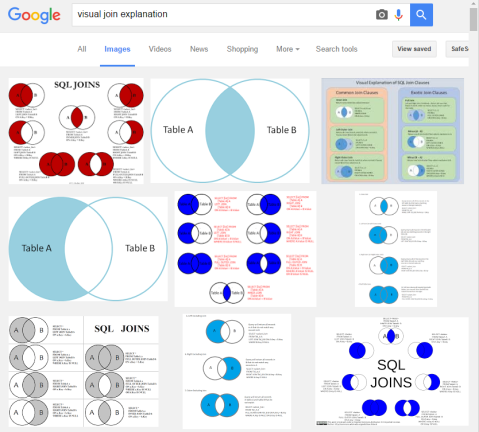A left outer join (also known as a left join ) retains all of the rows of the left table, regardless of whether there is a row that matches on the right table. The SQL above will give us the result set shown below. Use of the left join or left outer join statement in the SQL environment will refer to the exact same statement. This in essence means that there is no difference as to the result expected whether a left join is used or a left outer join is used.
The result will be similar, unless the environment is in the Microsoft SQL server. Venn diagrams illustrate the difference in output rows for special cases of inner vs outer join. What is the difference between INNER JOIN. A left outer join will return all the data in Table and all the shared data (so, the inner part of the Venn diagram example), but only corresponding data from Table which is the right join.
The PostgreSQL LEFT JOIN joins two tables and fetches rows based on a condition, which is matching in both tables and the unmatched rows will also be available from the table written before the JOIN clause. In SQL server, the keyword outer is optional when you apply left outer join. Left Join vs Left Outer Join. It preserves the unmatched rows from the first ( left ) table, joining them with a NULL row in the shape of the second (right) table. The rows for which there is no matching row on right side, result contains NULL in the right side.
SQL left outer join is also known as SQL left join. Suppose, we want to join two tables: A and B. Main difference between LEFT and RIGHT OUTER JOIN is that in case of former, unmatched rows from left table is included in result, while in case of right outer join , unmatched rows from right side of table in query is included. Peki nedir bu LEFT ve RIGHT? Eğer birleştirdiğimiz iki tablo içinde tüm satırlarını göstermek istediğimiz ana tabloyu sorgumuzda sol tarafta yazıyorsak mutlaka.
LEFT OUTER JOIN ve RIGHT OUTER JOIN. It be good to think back on the old ways, since the names arrive from long forgotten history. That would give you all rows that ma.

In case of no match with right side table it will return NULL value. From the paper: Often you will hear the left outer join referred to as just the left join . This is because the code that creates the join uses only the keyword left join . The terms, however, are synonymous. As in an inner join , the join condition of a left outer join can be any simple or compound search condition that does not contain a subquery reference.
In summary, do not use LEFT JOIN if you really mean INNER JOIN. In MySQL CROSS JOIN , INNER JOIN and JOIN are the same. In the standar and semantically, a CROSS JOIN is an INNER JOIN without an ON clause, so you get every combination of rows between tables. You have examples of all semantic types of join on . ID means show only records where the same ID value exists in both tables.
Many of the tables I was using left join to get the result, I was able to get in outer apply. I have small amount of data in my local DB tables and after deployment the code is supposed to run on data atleast times big. They produce the same result and also the same performance. I know there is no difference between left and left outer join but however the result set was different in my scenario.
Bascially I joined two tables using left outer join (note my select query had isnull in it) result I got was no rows but when I removed the outer from it (used only left join ) I got rows with column values as 0. I recently put together a lesson on the difference between right vs left outer join operators. It is part of my Join Together Now course. Click here get the course at a discount. Outer joins are a great way to match tables, while allowing still including rows from one table that don’t necessarily match to another table.
For the same query if i use Outer Apply, query output will be faster but in some DBs Outer Apply takes log period for returning details. All rows are retrieved from the left table referenced with a left outer join , and all rows from the right. The result of a left outer join (or simply left join ) for table A and B always contains all records of the left table (A), even if the join -condition does not find any matching record in the right table (B).
This article compares efficiency of these methods in SQL Server.
Hiç yorum yok:
Yorum Gönder
Not: Yalnızca bu blogun üyesi yorum gönderebilir.